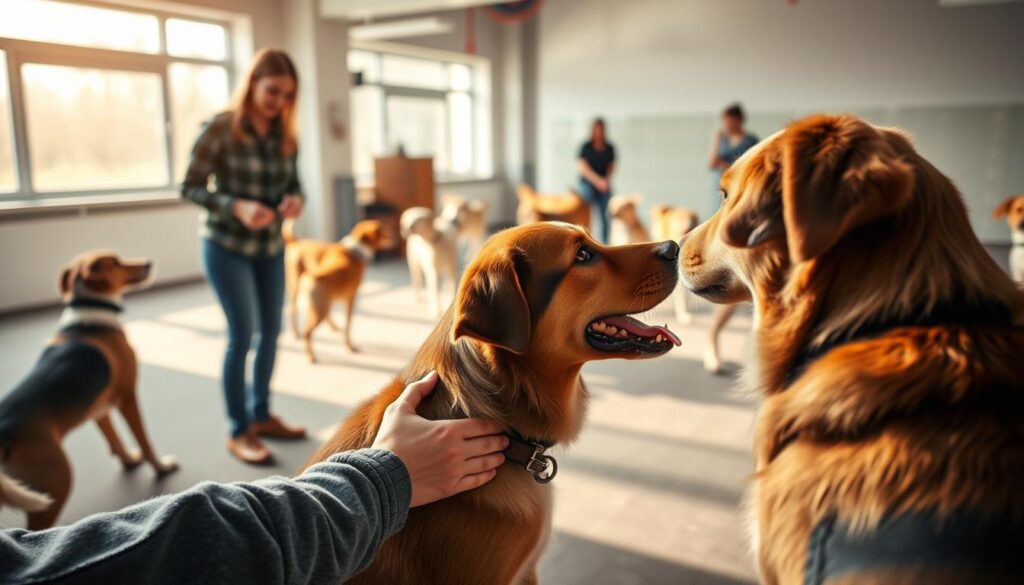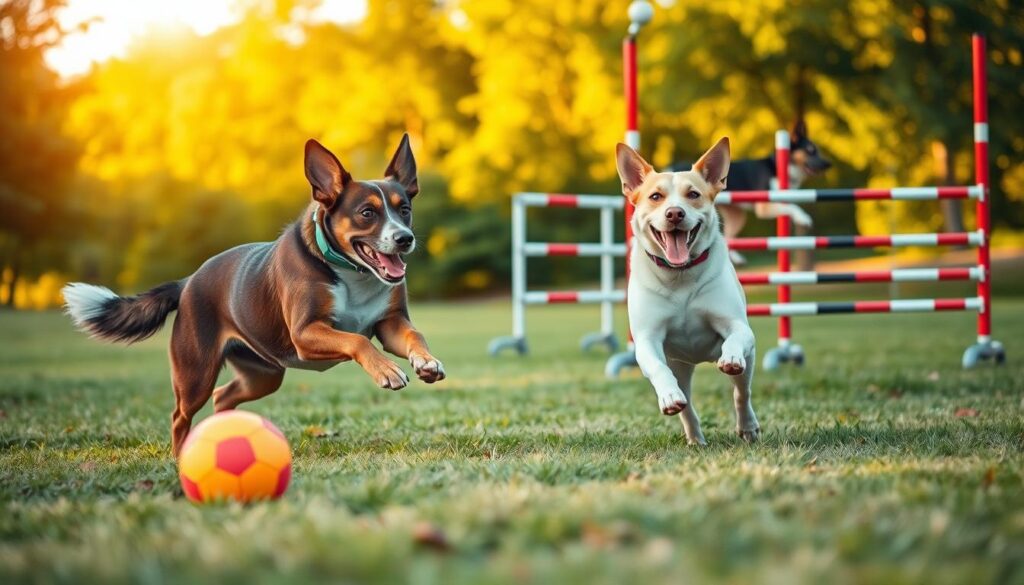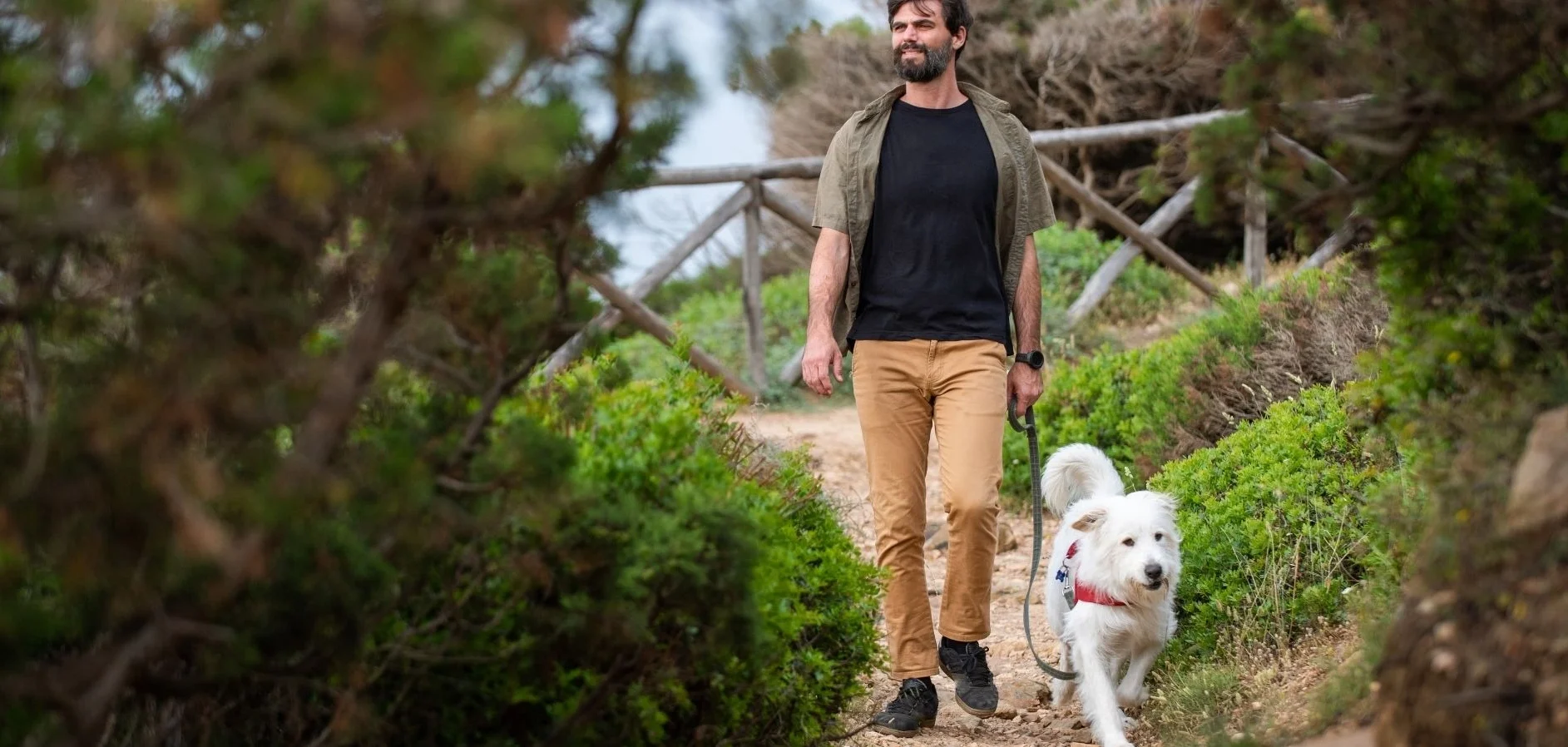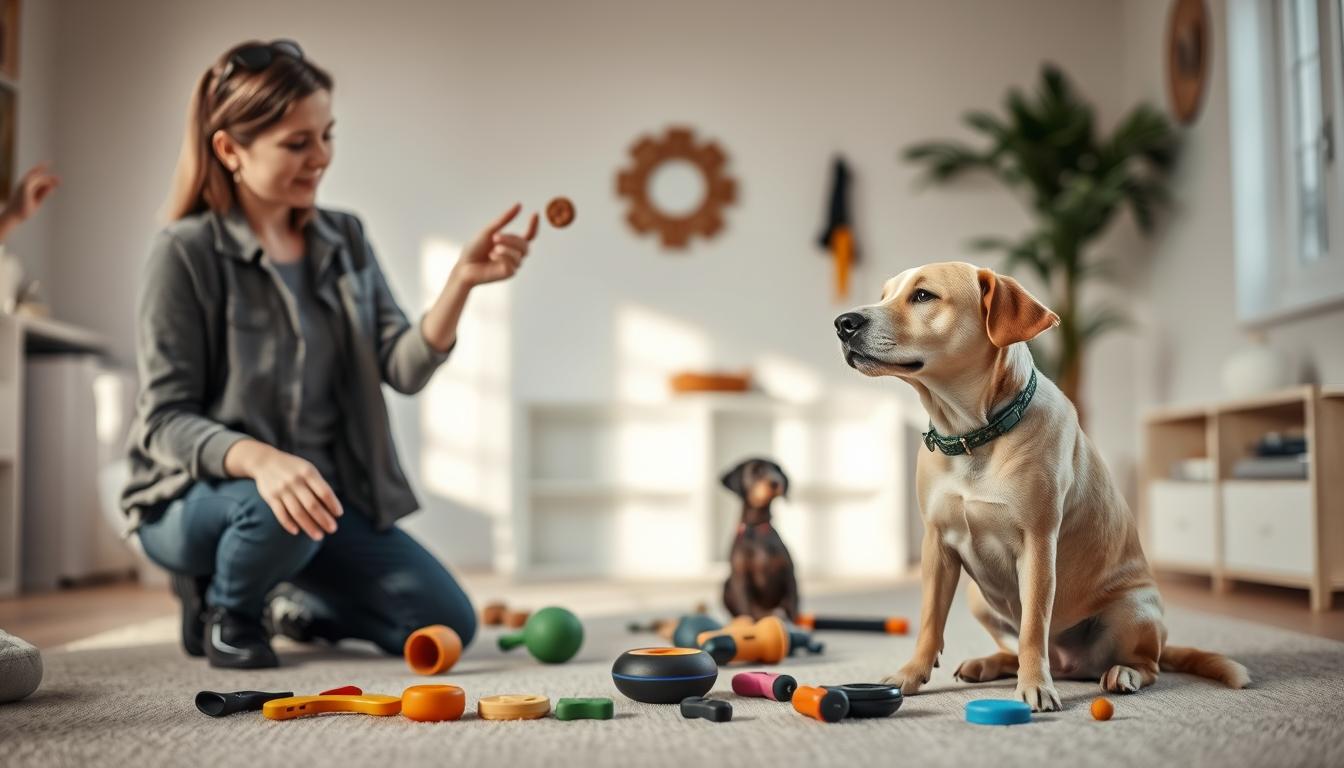Dog Behaviour Modification: Your Loving Guide to a Happier Pup
Table of Contents
Every dog owner has felt the pain of seeing their pet struggle with tough behaviors. My rescue dog, Max, changed from being reactive and anxious to a confident friend. This change came from using specific dog behavior modification techniques.
Changing your dog’s behavior isn’t about punishment. It’s about talking to them, understanding them, and training them in a smart way. Dog behavior modification is more than just teaching basic commands. It digs into the emotional reasons behind your dog’s actions.
Changing your dog’s behavior takes time, patience, and kindness. With the right strategies and methods, you can help your dog react better to things that upset them. You can also build a stronger bond with your dog.
Key Takeaways
- Dog behaviour modification focuses on understanding root causes of problematic behaviors
- Successful training requires empathy and consistent, positive reinforcement
- Each dog’s behavioral journey is unique and requires personalized approaches
- Professional guidance can significantly enhance behavior modification results
- Building trust is fundamental to successful canine behavior correction
Understanding the Foundations of Dog Behavior Modification
Training dogs to change their behavior is complex. It needs a deep understanding of how dogs think and learn. Dogs are social animals with their own way of communicating and learning. This shapes how they act around people and their surroundings.
To change a dog’s behavior, you must first understand the basics of how they learn and adapt.
The Science Behind Canine Learning
Dogs learn in several ways:
- Classical conditioning
- Operant conditioning
- Social learning
- Observational learning
Role of Environment and Past Experiences
Your dog’s actions are greatly influenced by their surroundings and past. Bad experiences, early socialization, and regular interactions are key in forming their behavior.
| Environmental Factor | Potential Behavioral Impact |
|---|---|
| Early socialization | Increased adaptability |
| Consistent training | Better behavioral control |
| Positive reinforcement | Enhanced learning response |
Impact of Dog-Owner Relationships
The bond between you and your dog is vital for successful training. Trust, communication, and consistency are essential for effective behavior change.
By grasping these foundational principles, you can create more focused and caring ways to change your dog’s behavior. This will also improve your bond with your furry friend.
Common Behavioral Issues in Dogs
It’s key to understand your dog’s behavioral challenges for effective training. Dogs show their feelings through actions. Knowing why they behave badly helps you train them better.
Many dog owners face common behavioral issues. These include:
- Excessive Barking: A sign of anxiety, defending territory, or seeking attention
- Aggression: Caused by fear, past trauma, or not being socialized enough
- Separation Anxiety: Showing up as destructive behavior when left alone
- Jumping and Leash Pulling: Signs of too much energy and poor training
Changing a dog’s behavior takes patience and a consistent effort. Each dog’s problem comes from different reasons. Knowing these helps tailor training to their needs.
Understanding your dog’s behavior is like learning a new language – it takes time, observation, and genuine connection.
Experts say most behavioral problems can be fixed with the right training. By finding the root cause and using structured training, you can turn bad behaviors into good ones.
The Veterinary Role in Behavior Assessment
Understanding your dog’s behavior needs a full approach. A dog behavior specialist knows that health issues can affect how dogs act. So, getting a vet’s opinion is key to finding and fixing any health problems.
Dogs can’t tell us when they’re in pain or feeling off. So, they might act differently to show they’re not feeling well. Vets are important in finding out why dogs behave strangely.
Medical Evaluation Process
A detailed medical check-up includes:
- Complete physical examination
- Comprehensive blood work
- Hormone level testing
- Neurological screening
- Pain assessment
When to Seek Professional Help
See a vet and a dog behavior specialist if your dog:
- Acts aggressively suddenly
- Shows unexplained fear
- Changes personality dramatically
- Has persistent anxiety
- Withdraws or seems very tired
Understanding Clinical Causes
Health issues can make dogs act differently. Thyroid problems, neurological disorders, and chronic pain can show up as behavioral issues. A dog behavior specialist works with vets to find health problems before starting behavior plans.
Early detection and comprehensive assessment are key to addressing your dog’s behavioral challenges effectively.
Creating a Structured Training Environment
Creating a good training space for dogs is key. It helps in changing their behavior. A special area for training reduces distractions and makes learning easier for your dog.
Here are important things to think about when setting up your training area:
- Choose a quiet, consistent location for training sessions
- Remove potential distractions like toys or other pets
- Ensure adequate lighting and comfortable temperature
- Use consistent training tools and rewards
Timing and routine are very important. Short, regular training sessions are best. Try for 5-10 minute sessions to keep your dog focused and avoid getting tired.
| Training Environment Factor | Recommended Approach |
|---|---|
| Session Duration | 5-10 minutes |
| Frequency | 2-3 times daily |
| Space Requirements | Quiet, distraction-free area |
| Training Tools | Consistent rewards, clicker, treats |
Consistency is the cornerstone of successful behavioral intervention for dogs. A structured, predictable training space helps your dog learn better and strengthens your bond.
Positive Reinforcement Techniques and Applications
Dog behavior modification programs use positive reinforcement. This method makes learning fun by rewarding good behavior. Learning these techniques can help change your dog’s behavior for good.
Types of Rewards and Their Effectiveness
Not all rewards are the same in dog training. Good rewards include:
- High-value treats
- Verbal praise
- Physical affection
- Favorite toys
- Play sessions
Every dog is different in what they like. Figuring out what motivates your dog is crucial for training. Some dogs love treats, while others enjoy playing or getting praise.
Timing and Consistency in Training
Timing is everything in dog training. Rewards should be given right after the good behavior. If timing is off, it can confuse your dog and slow learning.
Building Positive Associations
Changing bad behaviors needs positive connections. When good actions lead to fun, dogs are more likely to do them again. This way, they learn to replace bad habits with better ones.
“Training is about building a relationship, not just teaching commands.” – Professional Dog Trainer
Dog Behaviour Modification: Essential Steps and Strategies

Changing unwanted dog behavior needs a careful and patient plan. Knowing the basic steps can turn tough behaviors into good ones. Success comes from using gentle, consistent training that builds trust and clear communication.
Here are the key steps to start correcting unwanted dog behavior:
- Create a calm, predictable training environment
- Use positive reinforcement techniques
- Break complex behaviors into manageable steps
- Maintain short, focused training sessions
Experts say a structured plan is best for changing behavior. It’s important to know what triggers your dog and create plans just for them.
| Behavior Type | Modification Strategy | Expected Outcome |
|---|---|---|
| Excessive Barking | Desensitization Training | Reduced Vocalization |
| Leash Pulling | Positive Reinforcement | Calm Walking Behavior |
| Anxiety Responses | Gradual Exposure | Increased Confidence |
Remember that every dog learns differently. Patience and consistency are your most powerful tools in correcting unwanted dog behavior.
“Training is not about suppressing behavior, but guiding your dog toward positive interactions.” – Professional Dog Behaviorist
By following these steps, you’ll grow closer to your dog and solve behavioral problems.
Managing Aggression and Reactivity
Dog behaviour modification needs a careful plan for aggressive actions. Aggression in dogs often comes from fear, anxiety, or feeling threatened. Knowing why helps us find the right ways to help.
It’s key to spot aggression signs early for effective dog behaviour change. Dogs show discomfort in many ways that owners need to understand.
Identifying Trigger Points
Finding out what sets off aggression is important. Common things that can trigger it include:
- Territorial boundaries
- Resource guarding
- Fear-based responses
- Past traumatic experiences
- Physical discomfort or pain
Implementation of Safety Protocols
Keeping your dog safe is crucial when they’re reactive. Setting up safe areas and using protective gear can stop bad situations.
- Use secure leashes and harnesses
- Create physical barriers when necessary
- Maintain calm body language
- Avoid direct confrontational interactions
Progressive Desensitization Methods
Desensitization is a slow way to help dogs get used to things that scare them. Patience and consistency are key to making them less aggressive.
Professional guidance is recommended for complex aggression cases to ensure safe and effective training.
Using these methods takes dedication, understanding, and kindness. It’s about making your dog feel safe and confident.
Addressing Anxiety and Fear-Based Behaviors
Anxiety can turn your loving dog into a stressed-out bundle of nerves. Understanding how to correct canine behavior is key to helping your furry friend through tough times.
Dogs feel anxiety in their own way, unlike humans. Spotting the signs of fear-based behaviors is the first step in fixing these issues. Common signs include:
- Excessive pacing
- Uncontrolled whining
- Hiding or always wanting to be near owners
- Trembling when faced with certain triggers
Professional techniques can help your dog become more emotionally strong. It’s important to create a safe, predictable space to manage their anxiety.
| Anxiety Trigger | Recommended Intervention |
|---|---|
| Loud Noises | Gradual sound desensitization |
| Separation | Controlled exposure training |
| New Environments | Positive reinforcement techniques |
Your patience is crucial in correcting your dog’s behavior. Consistent, gentle methods help dogs regain confidence and lessen anxiety-driven reactions.
“Understanding your dog’s emotional landscape is the key to effective behavior modification.” – Dr. Patricia McConnell, Animal Behaviorist
Every dog’s journey with anxiety is different. Getting help from a professional dog trainer can offer customized strategies for your pet’s needs.
The Role of Exercise and Mental Stimulation
Training dogs is more than just teaching commands. It’s about keeping them physically active and mentally sharp. A happy, well-stimulated dog is less likely to get into trouble and more likely to be a great friend.

Dogs need both physical and mental challenges to stay healthy. Without enough stimulation, they might start to act out in ways that upset the household.
Physical Activity Requirements
Different dogs need different amounts of exercise. Here are some tips for training your dog:
- Small breeds: 30-60 minutes daily exercise
- Medium breeds: 60-90 minutes of active movement
- Large and high-energy breeds: 90-120 minutes of vigorous activity
Enrichment Activities
Mental games are just as important as physical ones. They keep dogs from getting bored and acting out:
- Puzzle toys that dispense treats
- Scent tracking games
- Interactive training sessions
- Hide-and-seek with toys
Structured Play Sessions
Playing with your dog in a structured way is key. It helps them learn good habits and gets them moving. Consistent, purposeful play strengthens the bond between you and your dog, making training fun and effective.
Building Trust and Communication
Creating a strong bond with your dog is key to changing their behavior. It’s not just about giving commands. It’s about understanding their language and feelings.
To change your dog’s behavior, you need a deep connection. This connection is built on respect and trust. Dogs talk to us through body language, sounds, and small signs. We must learn to read these signs well.
- Observe your dog’s ear position
- Watch tail movements
- Pay attention to eye contact
- Listen to different bark tones
Consistent communication is the base of changing behavior. Your dog trusts you when you act the same and guide them clearly.
“Trust is the invisible leash that connects dog and owner more powerfully than any physical restraint.”
To communicate well, you need to use a few important strategies:
- Use consistent verbal and non-verbal signals
- Maintain calm and confident body language
- Reward positive behaviors immediately
- Practice patience during training
| Communication Method | Impact on Dog Behavior |
|---|---|
| Consistent Commands | Reduces Confusion |
| Positive Reinforcement | Encourages Desired Behaviors |
| Calm Energy | Reduces Anxiety |
Changing your dog’s behavior is a journey of understanding and connection. Every interaction builds trust and makes your bond stronger. This makes training more fun and effective for both you and your dog.
Monitoring Progress and Adjusting Strategies
Watching your dog’s behavior change needs patience and careful watching. It also needs smart planning. The best way to change your dog’s behavior is to be flexible and adjust as needed.
When you start changing your dog’s behavior, it’s important to track it well. You should pay attention to what’s getting better and what’s not.
Recording Behavioral Changes
Make a plan to keep track of your dog’s progress:
- Use a notebook or a digital app
- Write down the behaviors you see and how often
- Keep notes on what triggers certain behaviors
- Take pictures or videos every week
Setting Realistic Milestones
Set goals that are realistic for your dog. Remember, progress is not always steady. Some weeks will be better than others.
- Start with easy goals
- Break big behaviors into smaller steps
- Celebrate every little win
- Change your goals if needed
Making Program Modifications
Be ready to change your dog’s behavior plan if it’s not working. If you’re not seeing the results you want, talk to a professional dog trainer or a vet behaviorist for help.
Flexibility and persistence are your greatest tools in dog behavior modification.
Conclusion
Behavior modification for dogs is more than just training. It’s about understanding and supporting your furry friend’s emotional journey. A skilled dog behavior specialist can help you navigate the complex world of canine communication.
This transformation turns challenging behaviors into opportunities for growth and connection. Your commitment to patience and positive reinforcement is key. It creates a powerful foundation for change.
Each small step you take builds trust, reduces anxiety, and strengthens your bond. Remember, behavior modification is a collaborative process. It requires consistent effort, compassion, and understanding.
Professional guidance from a dog behavior specialist can provide targeted strategies. Whether you’re addressing reactivity, anxiety, or specific behavioral challenges, the techniques outlined in this guide offer a roadmap. This roadmap leads to a more harmonious relationship with your four-legged companion.
Embrace the journey of behavioral transformation with an open heart and realistic expectations. Your dedication can unlock your dog’s potential. This creates a lifetime of mutual understanding and deep connection.
FAQ
What is dog behavior modification, and how does it differ from traditional dog training?
Dog behavior modification tackles the root of behavioral problems. It looks at why your dog acts a certain way. Unlike traditional training, it changes how your dog feels and acts through methods like desensitization and positive reinforcement.
How long does behavior modification typically take?
The time it takes to change behavior varies. It depends on the issue, your dog’s personality, and how well you stick to the plan. Simple problems might get better in weeks. But serious issues like anxiety or aggression could take months.
When should I consult a professional behavior specialist?
Get professional help if your dog is aggressive, anxious, or has compulsive behaviors. Also, if you’ve tried to change their behavior but failed. A pro can help if you think your dog’s behavior is linked to health issues or past trauma.
Are all dogs capable of behavior modification?
Most dogs can benefit from behavior modification. Success depends on your commitment, patience, and understanding of your dog’s needs. Age, breed, and past experiences can affect the process. But with the right approach and help, big changes are possible.
What role does exercise play in behavior modification?
Exercise is key in changing behavior. It reduces anxiety, burns energy, and keeps the mind active. Regular exercise helps prevent problems by releasing pent-up energy and improving emotional balance.
Is positive reinforcement always the best approach?
Yes, positive reinforcement is usually the best way to change behavior. It builds trust, strengthens your bond, and leads to lasting changes. But, complex cases might need a more detailed plan under professional guidance.
Can older dogs undergo behavior modification?
Older dogs can definitely benefit from behavior modification. It might take longer and need more patience. But, with consistent, specialized training, dogs of any age can learn new behaviors and change old habits.
How important is a veterinary assessment in behavior modification?
A vet check is very important. Medical issues can cause behavioral problems. A full medical evaluation helps find and address any underlying health issues, ensuring your behavior modification plan works effectively.
What are common signs that my dog needs behavior modification?
Signs include too much barking, aggression, separation anxiety, and destructive behavior. Fear-based reactions, compulsive behaviors, and not following commands are also signs. If these behaviors are ongoing and bother you, it’s time to try behavior modification.
How can I track progress during behavior modification?
Keep a detailed log of your dog’s behavior. Note how often and how severe the problems are. Record training sessions and set clear goals. Use videos, get professional advice, and be honest about progress to see if your strategies are working.
There are no reviews yet. Be the first one to write one.


